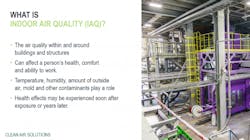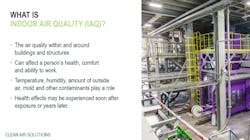How to tackle combustible dust and improve indoor air quality
Taylor Morgan is the mid-south regional manager for Camfil Air Pollution Control (APC), and has comprehensive experience in thermal spray, metalworking, and abrasive blasting applications, as well as industrial ventilation. During the webinar “HVAC/Air Quality: Common Indoor Air Quality Issues for Manufacturing or Processing Facilities,” Morgan answered questions during a live Q&A portion on how to maintain better indoor air quality.
PS: How do I know if I have a problem with indoor air quality and/or combustible dust?
TM: If you know you have a problem, the easiest and the simplest way is to do an eye and/or nose test. If I do an eye test and I see dust on the floor, or I see dust on a control panel, or I've got an operator constantly sweeping around an area and cleaning around an area, that's a good starting point. Another thing is to ask yourself, is there a smell in my facility? Does it smell like something's burning? Then you can realize, "Hey, I do have an issue. Let me dig a little bit deeper into this."
Of course, there could be potential employee complaints and/or symptoms like headaches, irritation, coughing, or sneezing. You might not notice it, but the employee might put it together that it could be coming from their facility. For example, I walk into my facility, I start noticing my eyes get a little bit irritated, my skin might be a little bit itchy. I walk outside those doors an hour later, and I feel a lot better.
PS: If you know you’ve got a problem and a dust-generating process at your facility, how do you go about taking action to better improve the air quality?
TM: The first step is you realize that you have a problematic area. The question becomes, "What do I need to do to take action, and what are my options to correct my bad indoor air quality?" The best thing is to reach out to an expert, a trusted advisor, who can help out with this. How long has this been a problem? What have you tried to do to fix it? When did you realize that this was a problem? For example, if it's a welding fume, one of your welders might say, "Hey, when I weld this, I’ve got smoke hovering over my shop and it never seems to disappear." Let's look at the worst area to attack or to tackle first, and then review your options.
PS: What is the most cost-efficient way to discover if you have a combustible dust problem?
TM: It is the customer's responsibility to test their dust for combustibility and have that on file. We can assume that sugar dust, wood dust, pharmaceutical dust, food dust (whether it's an ingredient in a flour or something along those lines) – we can assume those are combustible, but how combustible are they? It is the end-user's responsibility to have it tested for combustibility, that's the Kst and the Pmax, and to have on file on paperwork. If they've tested it, and it comes back as "non-combustible," they should have that on file too. If anybody ever comes in and asks, hey, have you ever had your dust tested? "Yes, I do, it's on file and it is non-combustible." Perfect. Or: "I've had my dust tested and it is combustible; here's how combustible it is, here's the piece of equipment that I have that filters my dust, and here's how I am compliant with this combustible dust."
PS: How effective is a dust collector at removing sub-micron particulate that remains suspended in the air?
TM: A dust collector with primary cartridge filters can filter sub-micron particulate that is suspended in the atmosphere. The effectiveness of this particulate is not an issue with the dust collector. The dust collector itself is part of the total system, a very important part of the system. But the other very important part of the system is the hood design, and the ductwork, and the conveying velocities leading up to the dust collector. Just because the filter media inside your dust collector can filter that sub-micron material, it doesn't mean that the sub-micron material floating around in the air can make its way into the dust collector. If there's a poor hood design, the capture velocity isn't there to capture that, you might be able to never properly remove the sub-micron particulate suspended in the air. That’s why you really need to have a trusted advisor or an expert to walk you through the whole process.
PS: In your experience, what's the best strategy for controlling indoor air pollution?
TM: There are multiple ways to attack an indoor air quality issue. Partnering up with a trusted advisor and expert will help you generate how you can capture fumes and nuisance dust before they get into the employee's breathing zone, or before they migrate away from the employee's breathing zone into the ceiling, or to the roof, or to a rafter, to a flat surface or to the ceiling tiles, or potentially to the building offices next door. Applications might be very similar between facilities, but each facility is unique, and operators and other persons working at each facility are going to be the best at helping solve the issues because they know what issues they're experiencing.


